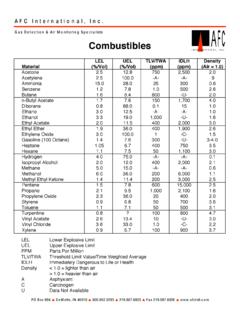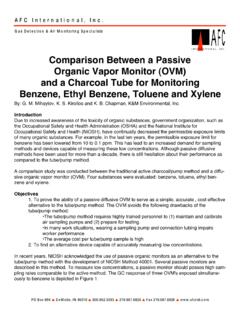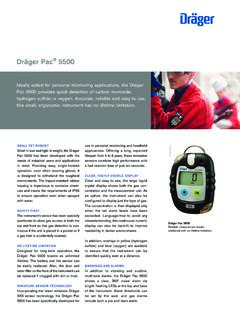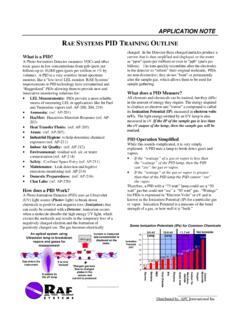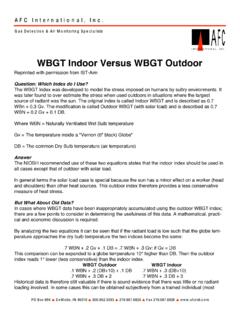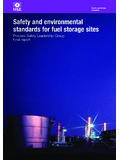Transcription of Leak Detection 101 - AFC International Inc
1 Leak Detection 101 Investigating a leak is simplified if you know the basics. By J. Scott KleppeSensit (J and N Enterprises, Inc.)Every day new gas services are added to provide economical energy to residents and businesses alike. These services are installed to exacting standards and procedures and normally provide years of maintenance free use. However, at some point, the service may require repair due to an unpredictable phenomenon, the gas leak. These leaks can be easy to locate and identify or they can be very tricky to of Gas - With any leak investigation it is important to know the basic properties of the gas(es) involved.
2 All gases require three basic components to burn; a combustible gas, an oxidizer or air, and heat. Without the right mixture of all three of these components, fire or explosion will not occur. But put them all together in just the right amounts and the results can be catastrophic. The gases that most service personnel deal with include propane, butane and natural gas. Each of these gases has specific physical properties that service personnel should know and understand. It will make the job of locating the sources of gas leaks easier and much more ChartGas Formula IgnitionGasFormulaIgnition PointLEL(LFL)UEL (UFL)Specific GravityMethaneCH4 App 1193 GasBlend1100-1200 632 MonoxideCO1191 - 1216 - 1094 SulfideH2S655-714 we review the flammability chart each gas has a name, chemical formula, specific gravity, ignition temperature in air, and the limits of flammability.
3 Most of these gases are made up of carbon and hydrogen (thus the chemical formulas). The specific gravity is the weight of the gas when compared to at the chart, methane and natural gas are both lighter than air and their respective specific gravities are less than one. Propane is one and a half times heavier than air; butane is about two times heavier than air. Consequently, when a gas heavier than air begins to leak, it will accumulate in low areas, and for those gases lighter than air, they will accumulate in high ignition temperature is the minimum temperature needed to ignite the fuel in air.
4 If the ignition temperature is too low, there is no way to burn the fuel. Don't believe for a minute that eliminating ignition sources is easy. One of the most common and most unpredictable sources of ignition is static electricity, such as the sparks that result when a person touches something after walking across the the last ingredient necessary to burn gas is the flammability limit. Each flammable gas has a minimal amount of gas required to burn called the Lower Explosive Limit (LEL). After reaching LEL, too much fuel can be present and the gas will no longer burn in air.
5 The greatest amount of gas that will burn in air is the Upper Explosive Limit (UEL).Probably the best example of LEL and UEL is what happens when starting a cold lawn mower engine. Assuming the air filter is clean and there is a spark, the engine choke must be set to start it or there won't be enough gas to run because LEL hasn't been achieved. Choke it too long and there will be too much gas because UEL has been reached so the engine won't run. Get the mixture just right, add spark or heat and air and you have the controlled gas explosions of an internal combustion of Leaks - Leaks come from a variety of sources but all of them can be put into four basic categories.
6 These include outside or third party damage, mechanical failure, corrosion, and gas accumulations. Typically third party damage results from accidental damage that has occurred while performing construction around the area of the gas line. Examples of mechanical failure include broken couplings, leaky piping, or bad regulators. Corrosion occurs when piping systems or tanks are unprotected from sacrificing its metal to some other area like the ground where it is buried. Finally, gas accumulations occur when valves or piping systems have been left open and not properly capped.
7 The gas concentration increases or accumulates until either the source is found and shut off properly or an incident for Detection - Typically, according to one leak detector manufacturer, a service person should carry a pressure gauge capable of reading pressure drops on a gas system in 1/10th inches of water column increments, a calibrated gas detector to alert the service person if they have entered a potentially hazardous environment, and leak Detection solution. Finally, the service person needs appropriate hand tools to disconnect or shut off the gas supply in case an emergency situation arises.
8 When handling leak investigations, the service person that has been called does not know if they have 10 days, 10 hours, 10 minutes or 10 seconds before something goes wrong. No one should perform an investigation without the proper are many different gas Detection instruments on the market today. All of them offer a variety of features and benefits. Keep in mind that the number one responsibility you have as a gas service person is protecting life and gas detectors fall into three basic types: The leak detector is used for pinpointing small, hard to find, gas leaks on piping systems.
9 These range in price and sensitivity. These are best used to help you speed up a leak investigation. Some brands offer separate calibrated alarms to warn you of gas build-ups approaching LEL. Leak detectors without calibrated alarms do not provide quantitative measurements to warn that you and your customer may be in a hazardous environment. Most leak detectors, though very sensitive, have a limited range and cannot locate leaks in areas with high concentrations. Leak detectors are traditionally sensitive to leak Detection solutions.
10 Use a leak detector first, then apply leak Detection solution secondly. The combustible gas indicator, or CGI, will provide direct readings in percent LEL. When equipped with the proper sensors these instruments can measure up to 100% gas. These instruments are well suited to measure the volume of gas when entering a residence or business to identify if the area is safe from gas build-ups. However, these instruments may not be the best tool for locating a leak because they are not as sensitive. They are excellent for locating the source of underground leaks.
